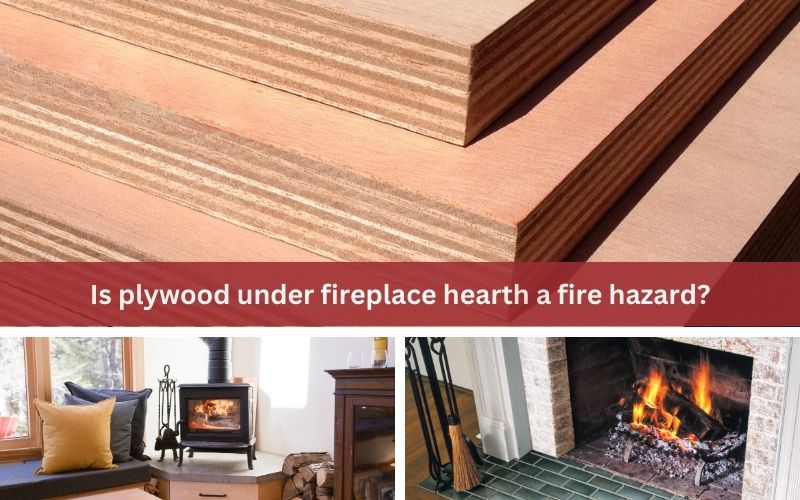Fireplace safety starts from the ground up, and many homeowners wonder: Is plywood under a fireplace hearth a fire hazard? The short answer is yes. In this article, we’ll explore why plywood should never be part of a hearth’s permanent structure, the risks involved, and safer alternatives to keep your home protected.
Why plywood might be placed under a hearth?
Plywood might be used temporarily under a fireplace hearth during construction as a form or base to support materials while they are being installed. However, plywood should never remain as a permanent part of the hearth structure because it is highly flammable and poses a serious fire hazard. For long-term safety, a fireplace hearth requires a non-combustible base that can withstand high temperatures without risk of ignition.
Typically, cement board is installed over the plywood to provide a heat-resistant substrate for tile, stone, or other non-combustible finishes. This combination ensures the hearth remains both stable and safe for use.

Is plywood under the hearth safe or a fire hazard?
Plywood under a fireplace hearth is a clear fire hazard and not considered safe. Plywood is a combustible material that can ignite when exposed to the intense heat generated by a fireplace over time. Even if the flames never directly touch the plywood, heat can transfer through the hearth materials and cause the wood to dry out, weaken, and eventually smolder or catch fire. Building codes require that hearths be constructed using non-combustible materials to prevent this risk. Leaving plywood beneath the hearth violates these safety standards and increases the chance of hidden fires, property damage, and insurance complications.
Combustible nature of plywood
Plywood is inherently combustible because it is made from layers of wood veneer bonded with adhesives. When exposed to heat, especially from a fireplace, plywood can ignite or smolder over time. Even if covered by tile or stone, the underlying wood remains at risk. For this reason, building codes strictly prohibit combustible materials like plywood in the construction of fireplace hearths.
Risk of heat transfer
Fireplaces generate intense heat that can transfer through non-combustible surface materials and reach any combustible layer beneath, such as plywood. This heat buildup can dry out the wood and increase the risk of spontaneous ignition, even without direct flame contact. Proper insulation and non-combustible substrates are essential to prevent dangerous heat transfer that could lead to hidden fires.
Long-term damage
Beyond immediate fire risks, using plywood under a hearth can lead to long-term structural problems. Constant exposure to heat can cause the wood to dry, crack, and weaken, compromising the stability of the hearth and surrounding flooring. Over time, this hidden deterioration can create both safety hazards and costly repairs. Using durable, fire-resistant materials from the start helps avoid these long-term issues.
For lasting safety, any combustible material like plywood should be replaced or properly covered with fire-resistant products such as cement board or concrete.

Additional fireplace safety tips
To keep your fireplace safe, always maintain a clear area by keeping flammable items like furniture and curtains at least three feet away. Use a protective screen or glass door to prevent sparks from escaping, and burn only seasoned, dry wood to minimize creosote buildup.
Regular maintenance is key, schedule annual chimney inspections and cleanings to prevent fire hazards. Never leave a fire unattended, fully extinguish it before leaving or sleeping, and install smoke and carbon monoxide detectors for added safety.
People Also Ask
Is it safe to burn plywood in a fireplace?
Burning plywood in a fireplace is not safe and should be strictly avoided. Plywood is manufactured using adhesives, resins, and chemicals that release toxic fumes when burned. These harmful emissions can damage your chimney, pollute indoor air, and pose serious health risks to you and your family. Additionally, burning plywood increases the risk of excessive creosote buildup, which can lead to dangerous chimney fires. For safety and clean air, always burn only seasoned, untreated hardwood in your fireplace.
Is it necessary to remove old plywood before installing a new hearth?
Yes, it is necessary to remove old plywood before installing a new hearth to ensure safety and compliance with building codes. Plywood is a combustible material that cannot provide the fire resistance required for a proper hearth base. Leaving plywood underneath, even with tile or stone on top, creates a hidden fire hazard as heat can transfer through and ignite the wood over time. To build a safe and durable hearth, all combustible materials should be replaced with non-combustible options such as cement board, concrete, or masonry.

In conclusion
Plywood under a fireplace hearth is a serious fire hazard due to its combustible nature and inability to withstand high temperatures. Even when covered by non-combustible materials like tile or stone, the heat from the fireplace can still transfer and pose long-term risks.
To ensure safety, always use proper non-combustible materials such as cement board, concrete, or stone when constructing or upgrading a hearth. Following building codes and best practices not only protects your home from fire hazards but also ensures lasting durability and peace of mind.
VINAWOOD – Vietnam Plywood Supplier Manufacturer









